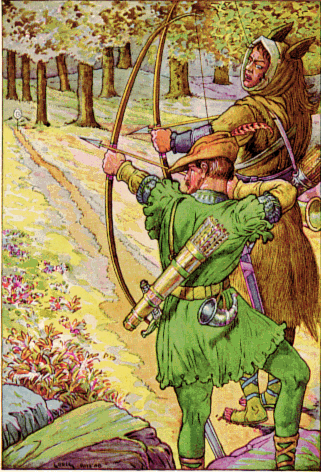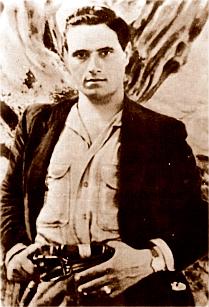
Can criteria used by New Testament scholars to uncover the historical Jesus (i.e., it is probably true if it is embarrassing, multiply attested, etc etc.) also be used on early ballads to see if we can know anything “probable” about the historical Robin Hood? Some people have “entertained reasonable doubts” about Robin Hood’s historicity, but at least one New Testament scholar has argued that if we can establish the probability of a deed or saying of Jesus Christ then it follows that he did exist. And we must not forget that “even fabricated material may provide a true sense of the gist of what Jesus Christ [ergo Robin Hood?] was about, however inauthentic it may be as far as the specific details are concerned” (from Dr McGrath’s review of Dr Dale C. Allison).
There is one modern historian who has much to learn from these pioneering advances in historiography made by historical Jesus scholarship, though since he is 94 years old now he had better hurry. Eric Hobsbawm has himself pioneered the historical study of social banditry (bandits who are accepted and honoured by societies as heroes) and, like the New Testament scholars, has made abundant use of mythical or legendary material. Unfortunately he never seems to have attended the same conferences as Jesus historians and so has missed out on the methods they have pioneered:
- the rigorous application of precisely articulated criteria to dig beneath the surface of unprovenanced mythical tales to discover the probable historical nuggets at the root of them all
- the use of even fabricated material, however inauthentic its specific details, in order to arrive at the true historical “gist” of the historical person at the centre of the narrative. (See NT Scholars are Pioneers for details)
Here is what Eric Hobsbawm has explained about his use of mythical or legendary material across the three different editions of one of his more famous works, Bandits. His bandit and bandit myth subjects ranged from the sixteenth to the twentieth centuries.
A rather tricky historical source:
I have relied largely on a rather tricky historical source, namely poems and ballads. So far as the facts of banditry are concerned, these records of public memory and myth are of course quite unreliable, however remotely based on real events, though they give much incidental information about the social environment of banditry, at least in so far as there is no reason why this should be distorted. But there is a more serious difficulty. How far does the ‘myth’ of banditry throw light on the real pattern of bandit behaviour? In other words, how far do bandits live up to the social role they have been assigned in the drama of peasant life? There is plainly some connection. I hope that in formulating it I have not gone beyond the bounds of common sense. (from the preface to the first edition of Bandits by Eric Hobsbawm, my emphasis)
Historical details derived from independent evidence, not criteria applied to the myths:
. . . in one respect criticism of the ‘noble bandit’ and other such stereotypes is well taken. In no case can we infer the reality of any specific ‘social bandit’ merely from the ‘myth’ which has grown around him. In all cases we need independent evidence of his actions. (p. 142 of the second edition of Bandits by Eric Hobsbawm, my emphasis)
Song and story cannot be used for evaluating historical reality underlying the narrative:
I have taken account of the most cogent criticism raised against my book, namely my use of bandit song and story both to trace the nature of the social bandit myth and, rather tentatively, to see ‘how far bandits live up to the social role they have been assigned in the drama of peasant life’. It is now clear that they cannot be used for the second purpose at all. In any case, the identifiable men around whom such myths formed, were in real life often very unlike their public image; including many of those cited as ‘good bandits’ in the early versions of this book. It is also now clear that they cannot be used for the first purpose, without a full prior analysis of this genre of literary composition, the transformations of its public, its traditions, topoi, modes of production, reproduction and distribution. In short, balladry, like the tapes of oral history, is a very slippery source, and, like oral tradition, it is contaminated by the way in which it is passed through the generations. Nevertheless, it can and must still be used for certain purposes. I hope I have (this time) not gone beyond the bounds of common sense in doing so. (p. xi of the third edition of Bandits by Eric Hobsbawm, my emphasis)
The above statement is explained further near the end of the same book:
The fifth and most convincing criticism of my book is the one I have already accepted in the Preface to this edition. It concerns my uncritical use of the literature and legend of banditry as a source. Very little about the historical reality of social banditry, let alone the career of any actual bandit, can be inferred from the content of the myths told about them or the songs sung about them. And insofar as anything can be inferred [see “the first purpose” in the above paragraph], it can only be after close and critical study of their textual history, such as was entirely absent from the original version of my argument. Of course this does not affect such texts as sources for what people believed about, or wanted from, or read into, banditry, although even here more caution is needed than I sometimes showed. (p. 182 of the third edition of Bandits by Eric Hobsbawm, my emphasis and underline)
The difficulty of finding any secure information at all, least of all from oral tradition:
Most of the bandits around whom such myths have formed are long dead: Robin Hood (if there was one) lived in the thirteenth century, though in Europe heroes based on figures from the sixteenth to eighteenth centuries are the most common, probably because the invention of printing made possible the main medium for the survival of ancient bandit memories, the cheap popular broadsheet or chapbook. Passing from one set of storytellers, from one place and public to another throughout the generations, such a mode of transmission can tell us very little of documentary value about the bandits themselves, except that, for whatever reason, their subjects are remembered. Unless they have left traces in the records of the law and the authorities who pursued them, we have hardly any direct contemporary evidence about them. Foreign travellers captured by bandits, notably in South-East Europe, have left such reports from the nineteenth century; journalists, anxious to interview more than willing young men in bandoleers, not before the twentieth. Nor can even their reports always be taken at face value, if only because outside witnesses rarely knew very much about the local situation, even if they could understand, let alone speak the sometimes impenetrable local patois, and resisted demands of sensation-hungry news editors. At the time this is being written, kidnapping foreigners — for ransom or in order to bargain for concessions from the government — has become fashionable in the Arabian republic of Yemen. So far as I can judge, little relevant information has been extracted from liberated prisoners. (p. 150-1 of the third edition of Bandits by Eric Hobsbawm, my emphasis)
So what sources did Hobsbawm use for the historical persons?
- Published material
- Seminars in various countries and leads picked up at these
- Primary research, including police records and newspaper reports
- Personal introductions
- Farmer and sergeant of police
- Former members of bandit band
- Others with direct knowledge of their activities
- First-hand contacts with the world of armed outlaws (friends and colleagues in Colombia, Italy and Mexico)
How long before the myth develops?
Bandit consciously feeds his contemporary myth to contradict his real deeds:
This is even more so in the case of the Sicilian bandit Giuliano, who lived and died in the high noon of press photographers and celebrity interviews in exotic places. But he knew what was expected of him (‘How could a Giuliano, loving the poor and hating the rich, ever turn against the masses of the workers?’ he asked, having just massacred several of them), and so did journalists and novelists. (p. 151 of the third edition of Bandits by Eric Hobsbawm, my emphasis)
In their own lifetime:
Some brigands can therefore acquire the legend of the good bandit in their own lifetime, or certainly in the lifetime of their contemporaries. Moreover, contrary to some sceptics, even famous bandits whose original reputation is unpolitical may soon acquire the useful attribute of being on the side of the poor. (p. 157 of the third edition of Bandits by Eric Hobsbawm, my emphasis)
First-generation scholarly biographer composes myth:
Tradition, of course, shapes our knowledge of even those twentieth century bandits — and there are several — about whom we have reliable first-hand knowledge. Both they and those who reported their ventures are familiar from childhood with the part of the ‘good bandit’ in the drama of the poor countrymen’s lives, and cast themselves or him for it. M. L. Guzman’s Memorias de Pancho Villa are not only based in part on Villa’s own words, but are the work of a man who was both a great Mexican literary figure and (in the judgment of Villa’s biographer) ‘an extremely serious scholar as well’. Yet in Guzman’s pages Villa’s early career conforms a good deal more to the Robin Hood stereotype than it seems to have done in real life. (p. 151 of the third edition of Bandits by Eric Hobsbawm, my emphasis)
Even the details are fabricated “immediately”:
Naturally, the more remote the public was — in time or space — from a celebrated brigand, the easier it was to concentrate on his positive aspects, the easier to overlook the negative. Nevertheless the process of selective idealization can be traced back to the first generation. In societies with a bandit tradition, if, among other targets, a brigand attacked those of whom the public opinion disapproved, he immediately acquired the entire Robin Hood legend — including impenetrable disguises, invulnerability, capture by treason and the rest. (p. 154-5 of the third edition of Bandits by Eric Hobsbawm, my emphasis)

Related post: Eric Hobsbawm versus the Mythicists
Neil Godfrey
Latest posts by Neil Godfrey (see all)
- Samaria in the Persian Period - 2024-04-15 11:49:57 GMT+0000
- No Evidence Jerusalem/Judea had a “Writing Culture” in Persian times — Israel Finkelstein - 2024-04-12 09:45:34 GMT+0000
- Questioning the Hellenistic Date for the Hebrew Bible — continuing - 2024-04-11 20:54:16 GMT+0000
If you enjoyed this post, please consider donating to Vridar. Thanks!

Has oral tradition ever been demonstrated to have accurately preserved events?
How many bandits had folklore?
Well, well, look who’s here. Mike “I love boobs” Wilson, who on other blogs heaps foul-mouthed insults upon me and who tells the world what a [%@!!X&)] ignoramus he thinks I am, comes here to ask me for information.
Well, Boobs, I guess you will have to read Hobsbawm’s book for yourself to find out your answer, won’t you. Or keep asking around — someone “on the internet” might tell you all you want to know — or why not just get on with something else and wait for a movie to come out and give you all you need? (But please don’t tell Mc^&$@ about it or its reviews — he tends to take them as authority and humiliates himself in public as a result.)